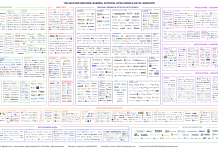The potential for AI to deliver a new generation of citizen-centric public services and efficient governance is too great to ignore, but how can it be done while decarbonising and ensuring sustainability goals?
Governments are now fully aware of the potential for AI to streamline administration, improve decision- making, provide data-driven insights, and create citizen-centric services, as well as being a key component of increasingly digital economies.
They play a critical role in supporting the general adoption of these technologies and fostering innovation for consumers and businesses despite the real concerns over energy demand and sustainability impacts.
It is incumbent on the technology industry and all potential adopters of AI and accelerated computing generally to ensure that secure, scalable, and completely sustainable infrastructure is available to deliver the maximum benefit of AI to all. We can bend the energy demand curve to decouple AI growth from energy consumption.
Government use of AI
The UK Government’s AI Opportunities Action Plan gives a detailed overview of how it will develop AI with specified growth zones and a focus on public services. It extends to infrastructure, skills development, and unlocking public and private sector data to become a global leader.
Similarly, the Irish Government has developed its own National AI Strategy, which was updated by the new government and in response to European Union (EU) AI regulations. It aims to increase the potential of Ireland’s research community to have a serious and significant impact on the global AI landscape.
At the EU level, the AI Act has provided a clear framework for local regulation transposition, offering safeguards for development without hindering innovation. This is supported by numerous stakeholders, including the EU AI Alliance promoting trustworthy AI, the public and private partnership AI Coalition, and the EU AI Champions initiative.
This is all backed by real investment, with a €200 billion fund that will include European AI gigafactories and partnerships with other key jurisdictions investing in an AI future, such as the United Arab Emirates.
Sustainability of AI
The issue at the heart of this wave of adoption and rapid pace of development in AI and accelerated computing is that it must be done sustainably.
Already, the data centres being either adapted or designed for AI workloads are using large amounts of energy, often straining national grids and threatening decarbonisation goals. Currently, data centres are thought to account for around 1% of global electricity consumption. In large economies such as the US, China, and the EU, data centres account for around 2-4% of total electricity consumption; in Ireland, it could be over 20%. Estimates are that AI-driven demand will see data centre capacity growth at up to 22% per year until 2030.
If governments are to ensure that AI does not become a barrier to sustainable development, supporting rather than threatening decarbonisation goals, they must be provided with AI and accelerated computing infrastructure that is efficient, scalable, secure, adaptable, and sustainable.
Triple strategy for sustainable AI use
Schneider Electric believes that the demand for AI and accelerated computing can be accommodated to provide the flexible, scalable, secure, and sustainable infrastructure necessary through three key strategic pillars: developing an energy strategy for the AI era, deploying advanced infrastructure, and providing comprehensive sustainability consulting.
An energy strategy for the AI era considers that most national grids are struggling to meet demand but are also undergoing digitalisation while bringing on ever larger proportions of renewable energy sources (RES). Schneider Electric supports companies in securing renewable energy and optimising on-site power generation with diverse sources like wind, solar, and hydrogen.
Schneider Electric has been active in negotiating power purchase agreements (PPA) to ensure that operators can access green energy, such as with Digital Realty in France and Spain, and Equinix in France, fostering investment in and the build-out of new RES. This is in conjunction with efforts to develop new energy infrastructure with distributed energy sources, such as microgrids while developing new capabilities for the smart grids of the future.
Workload demands
AI workloads have implications for physical rack space in data centres, power density, cooling solutions, and connectivity, demanding advanced infrastructure solutions.
Schneider Electric has developed a comprehensive portfolio of high- density, energy-efficient infrastructure for AI needs, exceeding 100kW per rack. This includes infrastructure components from grid-to-chip and chip-to-chiller, AI-powered remote monitoring and energy management software, and services for lifecycle optimisation. Through partnerships, such as with NVIDIA, we have developed and evolved reference designs to allow data centre designers and operators to access efficient, scalable designs. We also offer modular data centre designs and options for fast design and deployment where supporting infrastructure and expertise may be limited.
Power and insight
The development of high-density power provision and liquid cooling is essential in the new infrastructure environment. Schneider Electric’s advanced infrastructure solutions include the Galaxy VXL UPS, which features an ultra-compact, innovative design and a fault-tolerant architecture that maximizes availability and achieves up to 99% efficiency, all while minimizing the total cost of ownership. Additionally, through a majority stake in Motivair, Schneider Electric offers an enhanced liquid cooling portfolio that provides expertise in direct-to-chip liquid cooling solutions. This includes success stories like Vantage UK, where a customized chiller can reduce power consumption by up to 50% compared to other compressor technologies.
This unique technical capability is the basis on which we provide our Sustainability Consulting services, helping clients exceed decarbonisation goals. Our global services offer customers data-driven insights via EcoStruxure Resource Advisor, supported by 2,400 experts in 100+ countries and supplemented by 4,000 in-house power, cooling, and software engineers.
Holistic proposition
We firmly believe that this holistic energy strategy for the AI era, implemented through advanced design and infrastructure supported by comprehensive consultancy services, can decouple AI growth from energy consumption.
Further, we can bend the curve of energy consumption for data infrastructure by applying AI as a tool to measure and manage energy more efficiently, from grid to chip to intelligence.
In this way, governments and public services can be assured that the promise of AI for a citizen-centric generation of digital services can be achieved sustainably for the benefit of all.

This work is licensed under Creative Commons Attribution-NonCommercial-NoDerivatives 4.0 International.











